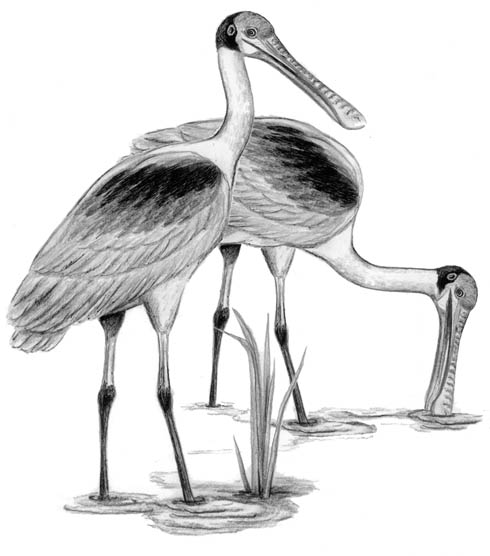
Dear Bird Folks,
On a recent trip to Florida I stopped off at Merritt Island National Wildlife Refuge and saw some great birds. The birds that really caught my eye were the Rufous Spoonbills. I spent quite a while watching those birds digging in the mud with their odd spoon-shaped bills. A spoon is great for digging in mud, but how does the bird get its food? Does it actually eat the mud?
– Tara, Williamsburg, VA
<it’s roseate,=”” tara,=”” the=”” bird=”” you=”” saw=”” on=”” merritt=”” island=”” was=”” a=”” roseate=”” spoonbill,=”” not=”” rufous=”” spoonbill.=”” i=”” believe=”” spoonbill=”” jazz=”” musician=”” from=”” boca=”” raton.=”” we=”” have=”” to=”” be=”” careful=”” confuse=”” two.=”” played=”” saxophone,=”” while=”” only=”” sound=”” makes=”” is=”” series=”” of=”” nonmusical=”” grunts=”” or=”” squawks.=”” for=”” being=”” stately=”” birds,=”” they=”” are=”” at=”” all=”” pleasant=”” listen=”” to.=”” yet,=”” i’d=”” rather=”” hear=”” an=”” entire=”” family=”” squawking=”” spoonbills=”” than=”” minute=”” jazz.=”” sorry,=”” rufous.=”” that’s=”” just=”” way=”” it=”” is.=”” <p=””>The Spoonbill is really a freakish bird. Only six species of them are found throughout the world. And only one, the roseate, is native to the Americas. Even down in South America, where they have tons of weirdo birds, you’ll only find this one species of spoonbill. A quick look at the bird’s bill and it’s clear how it got its name and you can see why few other birds wanted to copy it. The bird has a spoon growing out of its head. Who wants that? The only bird that was somewhat similar to a spoonbill was the Forked-face Finch, and they are long extinct.</it’s>
You would think a bird as odd as a spoonbill would be well studied, but you would be wrong. Surprisingly, not all that much is known about the spoonbill’s behavior. In North America their range is limited to a few locations along our southern coast. Perhaps researchers don’t want to travel to the hot, buggy, snake-filled spoonbill haunts, and I don’t blame them. However, we do know a few things about spoonbills. One of those things we know is that they don’t eat mud or even mud pie, which I think is a mistake on their part.
If you have ever watched a flock of spoonbills feeding you would notice that they forage by placing their bills into shallow water and then proceed to shake their heads back and forth like a group of disgusted Patriots’ fans watching the last Super Bowl. As the birds slice their sensitive “spoons” through the water, they are hoping to come into contact with tiny passing shrimp or minnows. The instant prey is detected, the spoon snaps shut and lunch is served. Having such sensitive bills and lightening fast reflexes help the birds feed in murky water, which may make it seem like they are feeding on mud, but they aren’t. In addition, they also have excellent eyesight and can easily pluck passing fish out the water, heron-style. Interestingly, even with their apparent advantage, spoonbills rarely eat soup or even chowder for that matter. I know; I’m surprised, too.
During the dark days of the millenary trade spoonbills were nearly wiped out by the dreaded plume hunters. For the most part, the hunters were after the white feathers of egrets, but since the spoonbills often nested among egrets they were guilty by association. A few hunters, perhaps looking to justify the killing, made fans out of the spoonbills’ wings. Wasn’t that a swell use of one of nature’s most unique creatures?
Years ago, a group of birders were observing a flock of spoonbills feeding in a quiet pond when a car drove up and some idiot jumped out and yelled, “Look, everyone! Flamingos!” What a bonehead that guy was. I felt bad for him. Okay, fine, that bonehead was me. I was a little excitable in those days, but it could have happened to anybody. At first glance one might confuse the Roseate Spoonbill with a flamingo. Both birds are a flaming pink color and inhabit similar habitat. But the flamingo has those ridiculously long legs and neck, with a beak that looks like a fat boomerang. Spoonbills, on the other hand, are much smaller birds, have white on their faces and necks, and, of course, have their signature spoon-shaped bill. In addition, spoonbills are proud birds and unlike flamingos, wouldn’t be caught dead being an ornament on somebody’s lawn.
As you mentioned, Tara, Merritt Island National Wildlife Refuge is a good place to see Roseate Spoonbills. In fact, it’s also a great place to see lots of other wading birds and waterfowl. There are numerous of hiking trails, plus a seven-mile wildlife drive, which allows the causal bird watcher to see a whole assortment of birds without having to even get out of the car. One word of caution: If you ever take the wildlife drive and some idiot starts yelling something about flamingos, just roll up your windows, lock your doors and drive away. You don’t want to get near that guy.